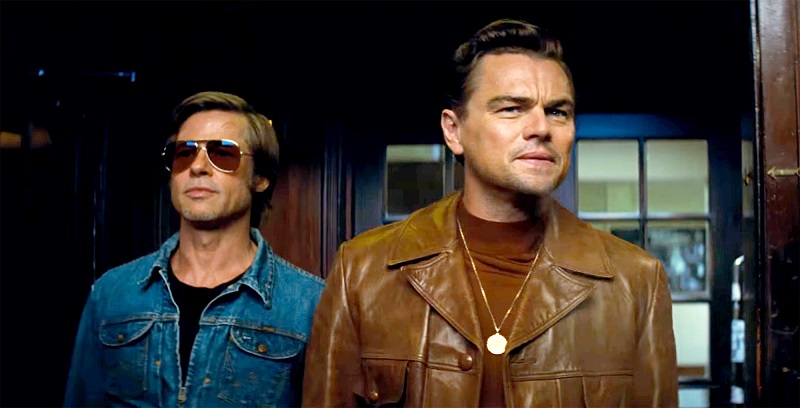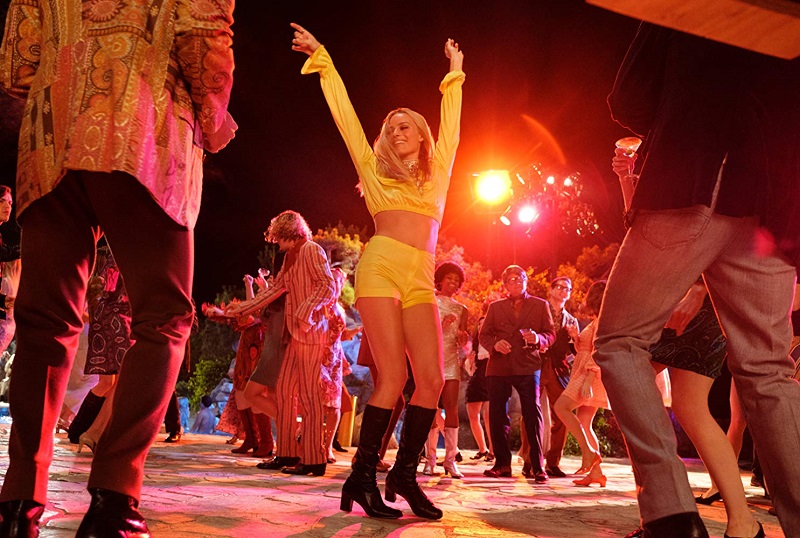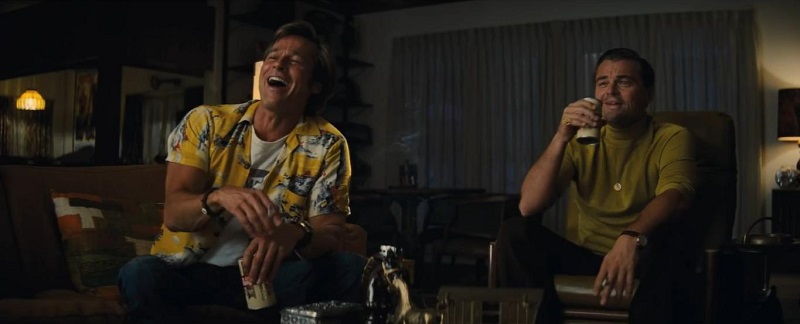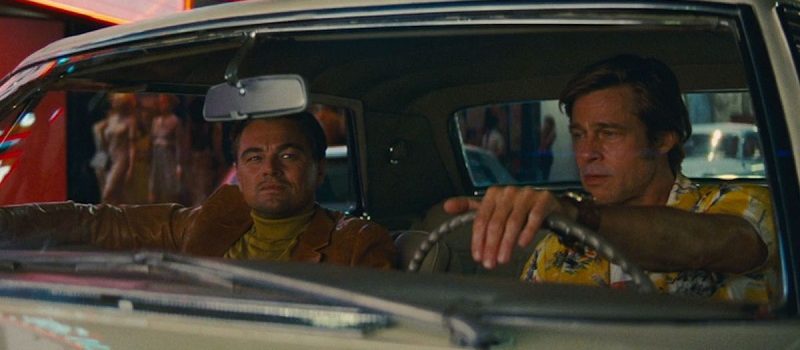Once Upon a Time … in Hollywood is a film clearly made by someone who absolutely adores, cherishes and seeks to share the magic that is the art of cinema. Quentin Tarantino, famously, had the flames of his film fandom fanned during his days working in a video store. As someone who shared that early vocational position, it’s educational value in that realm is priceless. Tarantino clearly has a style and a moviemaking feel that is solely his (i.e. when you are watching a QT movie, you know you’re watching a QT movie). But it is one that is greatly informed by the vastness that is film history. That has never been more on display than it is with his latest.

It’s also a complex needle he is trying to thread. Tarantino intertwines a fictional story of a (on the verge of being) washed up western actor (Leonardo DiCaprio), and his stunt double (Brad Pitt). The movie (and now more of a television) star lives in a Hollywood Hills home that is next door to Roman Polanski (Rafal Zawierucha) and Sharon Tate (Margot Robbie). One can immediately see where this is going. That’s the thing … how does Tarantino meld his fictionally crafted landscape of 1969 Hollywood that is on a speeding train heading straight for the Manson Family murders. It will explode, no question, but how?
Once Upon a Time … in Hollywood is the most unique all of Tarantino’s films. All his tropes are present, but this is a softer, gentler QT (for the most part) in that there is no outright violence until the third act and even at that point, it is inches from the film’s end zone.
DiCaprio and Pitt are sensational together and are given the richest of dialogue to work from over the course of the movie’s two hours and 45 minute runtime. Both are veterans of the filmmaker’s work (DiCaprio in Django Unchained and Pitt from Inglourious Basterds) and as such are primed to dive into that prose and give us some of the best work either actor has done over their career. Yes, that is saying something. But there is something incredibly unique about these characters, the journey audiences get to delightfully take with them, and most importantly, their bond.
Pitt’s Clint Booth and DiCaprio’s Rick Dalton emanate some serious chemistry. Their friendship comes off as truly touching, deep and real. These two are as close as friends of that time and of their age could be—this is the late 60s after all, and two men extolling the adoring nature of their friendship wasn’t like it is now. In the hands of Pitt and DiCaprio, the two men are so adoringly appealing that I could have spent another two hours with them. It is that kinship that carries the film from its opening through its raucous closing.
It would be impossible to quantify their performances, say giving one the “lead” moniker while having the other be “supporting.” Each commands equal billing. Both actors would tell you that the heights they achieved with their turns were largely due to harnessing the energy emitted by the other. I have rarely seen a collective performance from two actors that is as blissful as what DiCaprio and Pitt delivers in Tarantino’s latest … Jon Voight and Dustin Hoffman in Midnight Cowboy comes to mind.
Then, there is Robbie. The Oscar nominee (who will absolutely win at least one Academy Award one of these days). Ignore that reporter’s inquiry from Cannes about how little dialogue the actress had to work with. That was surely meant to be a “gotcha” moment for QT from the press who love to goad him into a controversy.
What Robbie does with the Tate characterization is nothing short of a love letter to a lost talent, whose contribution to our entertainment collective was violently cut short before we could ever discover what a gift she possessed. The Australian actress brings life to Tate in such a way that her family ought to feel that the filmmaker and the actress who portrays her have done everything in their power to have the late actress be remembered for the blinding light that was her being.
Tarantino also deserves some major props for how he intertwines Clint and Rick amongst the real life folks who walked the streets of Hollywood during that time. There are countless characters based on some Hollywood legends, such as Bruce Lee (Mike Moh), Steve McQueen (a stellar Damian Lewis), The Mamas and the Papas’ Mama Cass (Rachel Redleaf) and of course Polanski and Tate. Then, there is also that whole Charles Manson (Damon Herriman) thing.

How Tarantino weaves this web is incredibly organic, which adds to the truth that is what every single filmmaker hopes to achieve with each one of their efforts. Yes, the audience is engaged through his ensemble’s extraordinary performances. But the core of this stunning effort is the screenplay penned by the legendary director. His command of character dialogue is still in top form. It is a true joy and absolute pleasure to simply sit back and listen to these folks as they wax poetic on life, its vast challenges, their aspirations and even mundane details of how they approach each day.
Then, there is Tarantino’s keen awareness of the film industry, the art of moviemaking and most importantly, its history. His palette here is Hollywood’s backlot and the City of Angels itself. He made headlines, when filming his latest, due to his attention to detail and a production design that will likely earn an Oscar nomination. Tarantino took over major thoroughfares, such as Santa Monica Boulevard and Hollywood Boulevard and had storefronts erected that put the “practical” in practical sets. Out of sight is one phrase that comes to mind witnessing 60s LA all lit up. Actually, practical is an odd word to describe the sets. They felt more “integral” to giving the audience that core feeling that they are firmly in 1969 Hollywood. Not for one minute did the worries of the modern world enter the head.
No spoilers here, but the elephant in the room must be the Tate murder (who was 8 ½ months pregnant at the time). We are marching towards it the entire film! Let’s just say that the choices that the filmmaker makes with his film that tosses real life souls and fictional characters into a gumbo that is as spicy as can be and just as satisfying as the New Orleans culinary stalwart. Some may have an issue with Tarantino’s narrative decisions0, but let’s just say this: If you have seen any of his films—what he does with the last act of Once Upon a Time … in Hollywood should not be surprising in the least.
Also, the tale earns its title in the most well thought out manner. It’s a movie moniker that is exactly two hours and 45 minutes in the making. I adore when a film achieves that elusive feat where an ending occurs, credits roll, and the filmmaker’s choice of a name becomes crystal clear in terms of its descriptive power.
Another aspect of Once Upon a Time that is truly compelling is how the Golden Age of Hollywood’s morphing into the auteur-laden 70s cinematic landscape is chronicled. There really was a seismic shift in how things are done in Tinsel Town. Throughout QT’s latest, there are hints to the evolving moviemaking machine that produced many of the film works that inspired a young Tarantino to first seek this profession out in the first place.
Watching Tarantino’s nine films, it is easy to see how incredibly inspired he was by the filmmaking of the decade that truly starts as Once Upon a Time … in Hollywood closes. During the 70s, audiences would be dazzled by Raging Bull, Taxi Driver, Apocalypse Now and other films that would rattle the old guard and inspire the newbies to pick up a camera and further push the filmmaking envelope.

There is always so much to talk about after experiencing the Tarantino cinematic achievement that comes along every couple of years. This film is no different, and in fact, probably will spur a much deeper and vastly scoped conversation on a myriad of levels and topics. That, for me, is when film is at its best. I have rich memories of spending hours talking with my mother and father after experiencing films as a kid, such as Amadeus and say, Reds. There is much to dissect with the ninth entry in the Tarantino film lexicon and there is no question that is exactly how he envisioned it. Over his career, he spurs conversation—for better or worse. Once Upon a Time … In Hollylwood is his latest masterpiece. With its subject centered around Hollywood and the art of cinema, this is also a film that needs to be seen more than once considering who made it. There is much to take in. It is rich, resonant and ripe for the mental gymnastics that more often than not occur after experiencing a Tarantino film.
Grade: A+

